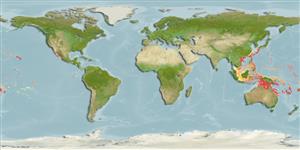>
Ovalentaria/misc (Various families in series Ovalentaria) >
Pomacentridae (Damselfishes) > Pomacentrinae
Etymology: Chrysiptera: Greek, chrysos = golden + Greek, pteron = fin, wing (Ref. 45335).
Eponymy: Dr Walter Albert Starck II (d: 1939) is a marine biologist, ichthyologist and pioneer of coral reef research, who first pointed out the damselfish species to Allen while diving at Osprey Reef, Coral Sea. [...] (Ref. 128868), visit book page.
Environment: milieu / climate zone / depth range / distribution range
Ökologie
seewasser riff-verbunden; standorttreu; tiefenbereich 20 - 60 m (Ref. 9710). Tropical; 35°N - 25°S
Western Pacific: anti-equatorial, from the Ryukyu Islands to Taiwan and from Queensland, Australia to New Caledonia. Recently reported from Tonga (Ref. 53797).
Size / Gewicht / Alter
Maturity: Lm ? range ? - ? cm
Max length : 7.0 cm SL Männchen/unbestimmt; (Ref. 7247)
Rückenflossenstacheln (insgesamt) : 13; Rückenflossenweichstrahlen (insgesamt) : 14 - 15; Afterflossenstacheln: 2; Afterflossenweichstrahlen: 15 - 17.
Adults inhabit rocky outcrops and crevices that are frequently situated in sand channels on outer reef slopes. Common in deeper sections of the outer reef about 20 to 60 m in depth (Ref. 7247). Oviparous, distinct pairing during breeding (Ref. 205). Eggs are demersal and adhere to the substrate (Ref. 205). Males guard and aerate the eggs (Ref. 205). Diurnal species (Ref. 54980; 113699).
Life cycle and mating behavior
Geschlechtsreife | Fortpflanzung | Ablaichen | Eier | Fecundity | Larven
Oviparous, distinct pairing during breeding (Ref. 205). Eggs are demersal and adhere to the substrate (Ref. 205). Males guard and aerate the eggs (Ref. 205).
Allen, G.R., 1991. Damselfishes of the world. Mergus Publishers, Melle, Germany. 271 p. (Ref. 7247)
IUCN Rote Liste Status (Ref. 130435: Version 2024-1)
Bedrohung für Menschen
Harmless
Nutzung durch Menschen
Tools
Zusatzinformationen
Download XML
Internet Quellen
Estimates based on models
Preferred temperature (Ref.
123201): 23.6 - 27.9, mean 26.5 °C (based on 89 cells).
Phylogenetic diversity index (Ref.
82804): PD
50 = 0.5000 [Uniqueness, from 0.5 = low to 2.0 = high].
Bayesian length-weight: a=0.01479 (0.00651 - 0.03363), b=3.00 (2.81 - 3.19), in cm total length, based on LWR estimates for this (Sub)family-body shape (Ref.
93245).
Trophic level (Ref.
69278): 2.8 ±0.32 se; based on food items.
Widerstandsfähigkeit (Ref.
120179): hoch, Verdopplung der Population dauert weniger als 15 Monate. (Preliminary K or Fecundity.).
Fishing Vulnerability (Ref.
59153): Low vulnerability (10 of 100).
Nutrients (Ref.
124155): Calcium = 143 [80, 248] mg/100g; Iron = 0.908 [0.563, 1.450] mg/100g; Protein = 18.5 [17.4, 19.5] %; Omega3 = 0.175 [0.107, 0.276] g/100g; Selenium = 24.6 [13.7, 45.2] μg/100g; VitaminA = 158 [54, 456] μg/100g; Zinc = 2.29 [1.59, 3.16] mg/100g (wet weight);
